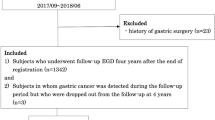Abstract
Endoscopic evaluation of the presence or absenceof gastritis is often performed in lieu of biopsy andhistologic diagnosis. The purpose of our study was toassess the value of endoscopic examination as a diagnostic test for gastritis. Twoendoscopists prospectively assessed the antrum of 73patients undergoing upper gastrointestinal endoscopy andgraded, on a scale of 0-4 (0 = completely absent, 4 = definitely present), the likelihood ofgastritis. The following features were also assessed atthe time of endoscopy: erythema, nodularity, erosion,edema, and friability. Two concomitant antral biopsies (3 cm from the pylorus on the greater curvatureof the stomach) were performed regardless of theendoscopic impression. The histologic findings weregraded independently on a scale of 0-3 by twopathologists who were not aware of the endoscopic findings.The following histologic features were graded: acuteinflammation, chronic inflammation, lymphoid aggregates,intestinal metaplasia, and quantity of Helicobacter pylori organisms. Receiver operatorcharacteristic analysis, a method derived from signaldetection theory, assesses the trade-off of sensitivityand specificity over all cutoff points of a test and is considered the best method by which to comparetests and determine the diagnostic utility of a giventest. Receiver operator characteristic analysis gave anarea of 0.65 ± 0.01 SE for endoscopy as a test for gastritis (0.5 = chance, 1 = perfect) asdefined by the histologic presence of inflammation.Additionally, endoscopy as a test for the presence ofhistologically proven Helicobacter pylori gave an area of 0.55 ± 0.01 SE. All endoscopicallygraded features treated as separate tests for gastritisand/or H. pylori gave areas of approximately 0.44-0.61,indicative of a poor test. While H. pylori was always associated with at least some degree ofinflammation, linear regression analysis revealed nocorrelation among any of the histologic features or ofany histologic feature with any endoscopic feature. We conclude that a tissue diagnosis is essentialfor the proper diagnosis of gastritis.
Similar content being viewed by others
REFERENCES
Sauerbruch T, Schreiber MA, Schüssler P, Permanetter W: Endoscopy in the diagnosis of gastritis. Diagnostic value of endoscopic criteria in relation to histological diagnosis. Endoscopy 16:101–104, 1984
Atkins L, Benedict EB: Correlation of gross gastroscopic findings with gastroscopic biopsy in gastritis. N Engl J Med 254(14):641–645, 1956
Cronstedt JL, Simson IW: Correlation between gastroscopic and direct vision biopsy findings. Gastrointest Endosc 19(4):174–175, 1973
Elta GH, Appelman HD, et al: A study of the correlation between endoscopic and histological diagnoses in gastroduodenitis. Am J Gastroenterol 82(8):749–753, 1987
Fung WP, Padadimitriou JM, Matz LR: Endoscopic, histological and ultrastructural correlations in chronic gastritis. Am J Gastroenterol 71(3):269–279, 1979
Greenlaw R, Sheahan DG, et al: Gastroduodentis. A broader concept of peptic ulcer disease. Dig Dis Sci 25(9):660–671, 1980
Kang JY, LaBrooy SJ, Wee A: Gastritis and duodenitis-A clinical, endoscopic and histological study and review of the literature. Ann Acad Med 12(4):539–544, 1983
Myren J, Serck-Hanssen A: The gastroscopic diagnosis of gastritis with particular reference to mucosal reddening and mucous covering. Scand J Gastroenterol (9):457–462, 1974
Misiewicz JJ: The Sydney system: Histologic division. J Gastroenterol Hepatol 65(3):209–222, 1991
Appelman HD: Gastritis: Terminology, etiology, and clinicopathologic correlations: Another biased view. Hum Pathol 25:1006–1019, 1994
Furth EE, Rubesin SE, Levine MS: Pathologic primer on gastritis: an illustrated sum and substance. Radiology 197:693–698, 1995
Metz CE: Basic principles of ROC analysis. Semin Nucl Med 8:283, 1978
Metz CE: ROC methodology in radiologic imaging. Invest Radiol 21:720, 1986
Bamber D: The area above the ordinal dominance graph and the area below the receiver operating graph. J Math Psychol 12:387, 1975
Beck JR, Schultz EK: The use of relative operating characteristic (ROC) curves in test performance evaluation. Arch Pathol Lab Med 110:13, 1986
Hanley JA, McNeil BJ: The meaning and use of the area under a receiver operating characteristic (ROC) curve. Diagn Radiol 143:29, 1982
Hanley JA: Receiver operating characteristic (ROC) methodology: The state of the art. Crit Rev Diagn Imaging 29:307, 1989
Begg CB, McNeil BJ: Assessment of radiologic tests: Control of bias and other design considerations. Radiology 167:565–569, 1988
Ransohoff DF, Feinstein AR: Problems of spectrum and bias in evaluating the efficacy of diagnostic tests. N Engl J Med 288:926–930, 1978
Rights and permissions
About this article
Cite this article
Belair, P.A., Metz, D.C., Faigel, D.O. et al. Receiver Operator Characteristic Analysis of Endoscopy as a Test for Gastritis. Dig Dis Sci 42, 2227–2233 (1997). https://doi.org/10.1023/A:1018854315027
Issue Date:
DOI: https://doi.org/10.1023/A:1018854315027




